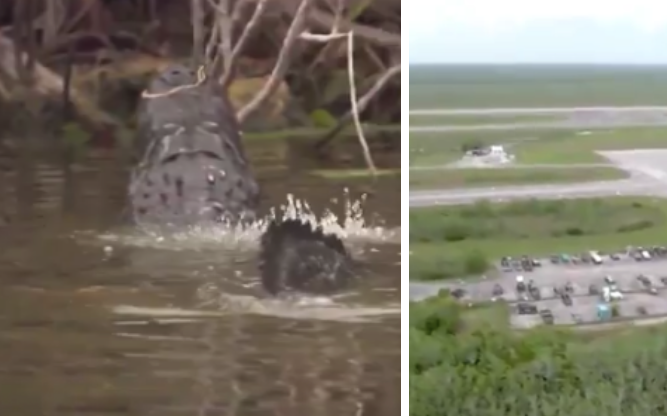Key Point Summary – Alligator Alcatraz Immigration Center
- DHS approves Florida’s new immigration detention plan
- Center nicknamed “Alligator Alcatraz” to open in Everglades
- Facility will house up to 5,000 detainees
- Site includes massive runway for transport
- Officials say the remote swamp location boosts security
- Public and environmentalists raise serious concerns
- Detentions set to begin next month
A Swamp Fortress for Migrants
The Department of Homeland Security has officially signed off on Florida’s bold and bizarre plan to detain thousands of undocumented migrants in one of the most remote spots in America—the Everglades.
The proposed facility, nicknamed “Alligator Alcatraz,” will sit on a deserted airfield surrounded by swamps, gators, and miles of uninhabitable wilderness. According to state officials, the first detainees could arrive within weeks.
Supporters say it’s genius. Critics say it’s dystopian.
And now, the world is watching.
Florida’s ‘Alligator Alcatraz’ Immigration Center Gets DHS Green Light
Florida Chief of Staff James Uthmeier confirmed the federal approval during a press briefing, calling it “a monumental step forward in securing our border, state-first.”
Uthmeier revealed that the detention center will rise from the ruins of an abandoned airfield once meant to be the largest airport in the world. Its 11,000-foot runway is still intact—and ready to receive aircraft carrying detainees.
“Logistically, it’s perfect,” Uthmeier said. “And the Everglades offer a kind of natural fencing we couldn’t replicate with steel.”
He wasn’t joking.
A Wall of Gators and Sawgrass
The facility is being framed as “temporary.” But critics say it looks more like a permanent fortress. The Everglades are notoriously unforgiving. No roads. No neighbors. Just swamps, snakes, and sun.
State officials are leaning into the imagery. They’ve dubbed the site “Alligator Alcatraz” because of its isolation. Uthmeier even called it “Mother Nature’s maximum-security prison.”
Drones, armed patrols, and thermal imaging will assist with surveillance, but officials claim the location itself will prevent escape.
Still, the nickname has drawn backlash—and fear.
Outrage Grows Over ‘Alligator Alcatraz’
Immigrant rights groups exploded with criticism following the announcement.
“This is cruelty disguised as innovation,” said Maria Gonzalez of the Florida Immigration Justice Center. “You don’t send humans to the middle of a swamp to disappear them.”
Others questioned the legality of placing a detention facility in a fragile national ecosystem. Environmentalists warn that construction and aircraft traffic could harm endangered species and pollute wetlands already under threat.
But the state insists it’s following all guidelines. And now that DHS has signed off, Florida has no intention of backing down.
5,000 Beds, One Giant Runway, Zero Neighbors
The scope is staggering.
Uthmeier says the full plan could house up to 5,000 detainees at multiple sites, with the Everglades location serving as the largest hub. It will be equipped to process large groups quickly—especially those flown in directly.
The old airfield allows for 24/7 landings of large cargo planes, giving the facility a strategic edge. Medical tents, portable barracks, and mobile command centers are all being shipped in this week.
Officials say the site will be functional by early next month.
Supporters Call It “Smart and Secure”
Florida Governor Ron DeSantis hasn’t commented publicly yet, but insiders say he fully supports the project.
Conservative groups have praised the move as bold, efficient, and long overdue. “If we’re serious about stopping illegal immigration,” one strategist said, “we need solutions that are as tough as the problem.”
Uthmeier echoed that sentiment. “This isn’t just about policy. It’s about deterrence.”
The message, he claims, is simple: If you enter illegally, don’t expect comfort. Expect consequences.
But Critics See a Dark Future
Human rights advocates warn that these centers could devolve into legal gray zones—out of sight and out of mind.
“Remote locations mean fewer lawyers, fewer cameras, and fewer checks on abuse,” said Andrea Mendez, an immigration attorney in Miami. “It’s intentional. That’s the scariest part.”
Some have compared the idea to black sites, where transparency vanishes. Others worry about emergency evacuations. What happens if a hurricane hits? How do you rescue 5,000 people from a swamp?
For now, no answers.
A Political Flashpoint Before Election Season
The move is already turning into a 2024 election talking point.
Trump supporters applaud the action. “DeSantis gets it done,” one posted. “He’s serious about the border, not just talking.”
But opponents call it a distraction. “They can’t fix housing or healthcare, but they can build a prison in a swamp?” asked one X user.
As the political divide deepens, the detainees—many of them asylum seekers—will soon find themselves at the center of it all.
And their first stop? A swamp surrounded by gators.
Is This a Test Case for More?
Some insiders believe Florida’s plan is only the beginning.
If “Alligator Alcatraz” works, similar centers could pop up across the U.S.—in deserts, mountains, and other remote areas. Already, several states are in talks to model their own versions.
For the Department of Homeland Security, this may be an experiment. For Florida, it’s already reality.
The Clock Is Ticking
Construction crews are racing against the clock. The site, currently dotted with overgrown runways and rusting hangars, will soon transform into America’s newest immigration outpost.
Tent cities are being erected. Guard towers rise each day. Power grids are being reinforced. And satellite communication lines are going in fast.
Uthmeier says the goal is functionality by the 1st of next month. That gives officials just days to get the job done.
Meanwhile, activists are preparing lawsuits. Public outcry is mounting. And all eyes are turning to the heart of the swamp.




